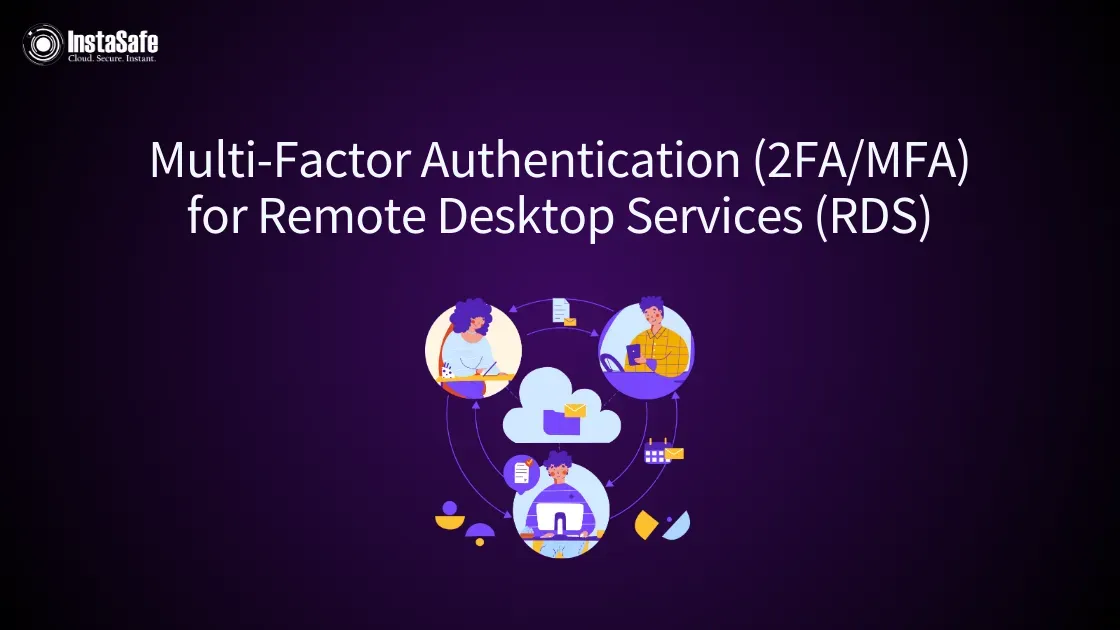Multi-Factor Authentication for Remote Desktop Services

Remote Desktop Services (RDS) has emerged as an invaluable tool, enabling users to access desktops and applications from anywhere. However, with this convenience comes the pressing need for robust security measures.
This is where Multi-Factor Authentication (MFA), also known as Two-Factor Authentication (2FA), plays a pivotal role in safeguarding RDS environments. As organisations increasingly adopt remote work models, understanding and implementing RDS MFA has become essential for maintaining a strong cybersecurity posture.
What is RDS?
Remote Desktop Services (RDS), formerly known as Terminal Services, is a Microsoft technology that enables users to access Windows desktops and applications remotely. RDS allows organisations to centralise their IT resources while providing secure access to users from various locations and devices.
This technology is very useful for businesses with remote workers, branch offices, or those looking to implement a bring-your-own-device (BYOD) policy.
Key Components of RDS include:
- RD Gateway: Acts as a secure entry point for remote connections.
- RD Web Access: Provides a web-based interface for accessing remote applications and desktops.
- RD Web Client: An HTML5-based client for connecting to remote resources without additional software.
- RD Connection Broker: Manages and load balances remote desktop connections.
- RD Session Host: Hosts Windows desktop environments or applications.
Understanding these components is crucial when implementing MFA for RDS, as each plays a role in the overall security architecture.
The Growing Need for MFA in RDS
While RDS provides unparalleled convenience, it also presents potential security risks. Using just usernames and passwords for logging in isn't safe enough anymore. Cybercriminals on the internet can guess or steal these and break into important computer systems.
That's why we need something called MFA (multi-factor authentication) for RDS (Remote Desktop Services).
MFA is like having extra locks on your door. It asks users to prove who they are in more than one way before letting them in. This makes it much harder for hackers to get in, even if they somehow figure out someone's password.
By using MFA, companies can better protect their computer systems and important information from cyber attacks. In the context of RDS, MFA acts as a crucial defence mechanism against various threats, including:
- Brute force attacks
- Credential stuffing
- Phishing attempts
- Man-in-the-middle attacks
- Keylogging malware
By implementing MFA for Desktops, organisations can dramatically improve their security posture and protect against these common attack vectors.
Components of RDS MFA
To fully secure an RDS environment, it's essential to implement MFA across various components:
MFA for RD Gateway
RD Gateway acts as a secure entry point for remote connections. Implementing MFA for RDS Gateway ensures that users must pass an additional authentication challenge before accessing internal network resources. This layer of security is critical for organisations that expose their RD Gateway to the internet.
MFA for RD Web Access
RD Web Access provides a web-based interface for users to access remote applications and desktops. Adding MFA to the RD Web Access login process enhances security for browser-based remote sessions.
This is particularly important as web-based access is often the most convenient method for users, making it a prime target for attackers.
MFA for RD Web Client
The RD Web Client is an HTML5-based client that allows users to connect to remote resources without installing additional software. Integrating MFA with the RD Web Client ensures secure access across various devices and platforms, including mobile devices and non-Windows operating systems.
MFA for Remote Desktop Protocol (RDP)
RDP is the underlying protocol used for remote connections in Windows environments. Implementing MFA for RDP connections adds an extra security layer directly to the remote desktop access process. This is crucial for protecting against unauthorised RDP access attempts, which are frequently targeted by cybercriminals.
Benefits of Implementing MFA for RDS
- Enhanced Security: Multiple forms of identification make it much less likely that someone will get in without permission. This multi-layered method makes it much harder for attackers to get into user accounts.
- Compliance: Many industry regulations and cyber insurance policies require MFA implementation for remote access solutions. By implementing MFA for desktops, organisations can more easily meet compliance requirements and potentially reduce insurance premiums.
- User-Friendly: Modern MFA solutions offer various authentication methods, allowing users to choose the best option. This flexibility can lead to higher user adoption rates and less resistance to security measures.
- Centralised Management: RDS MFA can be managed centrally, making it easier for IT teams to enforce security policies across the organisation. This centralised approach simplifies administration and ensures consistent security practices.
- Adaptable: MFA can be configured to meet specific organisational needs, such as applying different policies for different user groups or devices. This adaptability allows organisations to balance security and usability based on their unique requirements.
- Reduced Risk of Data Breaches: By requiring an extra layer of authentication, MFA significantly reduces the likelihood of successful data breaches, protecting sensitive information and maintaining customer trust.
- Improved Auditing and Monitoring: MFA solutions often come with advanced logging and reporting capabilities, providing better visibility into access attempts and potential security incidents.
MFA Methods for RDS
- Push Notifications: Users receive a prompt on their mobile device to approve or deny access.
- Time-Based One-Time Passwords (TOTP): Users enter a temporary code generated by an authenticator app.
- SMS or Email OTP: A one-time code is sent to the user's registered phone number or email address.
- Hardware Tokens: Physical devices that generate unique codes for authentication.
- Biometrics: Fingerprint or facial recognition can be used as an additional factor.
- Security Questions: Users answer predefined questions to verify their identity.
Implementing MFA for RDS
To implement RDS MFA, organisations typically follow these steps:
- Choose an MFA Solution: Select a reliable MFA provider that supports RDS integration. Consider factors like ease of use, supported authentication methods and integration capabilities.
- Configure RDS Components: Set up RD Gateway, RD Web Access and RD Web Client to work with the chosen MFA solution. This may involve installing additional Software or configuring existing RDS roles.
- User Enrollment: Guide users through the process of enrolling in MFA and setting up their preferred authentication methods. Assist and give clear directions to make sure the transfer goes smoothly.
- Policy Configuration: Define MFA policies based on organisational requirements, such as which user groups require MFA and under what circumstances. Consider implementing risk-based authentication policies for more granular control.
- Testing: Thoroughly test the MFA implementation to ensure it works seamlessly with RDS components. Conduct both functional and security testing to identify any potential issues.
- User Training: Teach people why MFA is important and how to use it correctly. Provide training materials and support resources to help users adapt to the new authentication process.
- Monitoring and Optimization: Continuously monitor the MFA implementation and gather user feedback. Use this information to optimise the configuration and address any usability or security concerns.
Best Practices for RDS MFA
To maximise the effectiveness of MFA for Desktop, consider the following best practices:
- Use Strong First-Factor Authentication: Implement strong password policies in addition to MFA. Support the use of password managers to assist individuals in creating and managing complicated, one-of-a-kind passwords.
- Offer Multiple MFA Options: Provide users with a choice of authentication methods to improve adoption and user experience. This flexibility can help accommodate various user preferences and technical limitations.
- Enable Offline MFA: Implement solutions that allow for MFA even when internet connectivity is limited. This ensures that users can still access critical resources in case of network issues.
- Regular Audits: Continuously monitor and audit MFA usage to identify and address any security gaps. Regularly review access logs and authentication patterns to detect potential security incidents.
- Keep Software Updated: Regularly update RDS components and MFA solutions to ensure the latest security features are in place. This includes updating the Software and adding security fixes to any hardware tokens that have been used.
- Implement Conditional Access: Configure MFA policies based on factors like user location, device type, or time of access. This allows for more granular control over authentication requirements.
- Use Secure Protocols: Ensure that all communications between RDS components and MFA systems are encrypted using secure protocols such as TLS 1.2 or higher.
- Implement Session Management: Configure appropriate session timeouts and re-authentication requirements to minimise the risk of unauthorised access through abandoned sessions.
- Plan for MFA Failures: Develop and document procedures for handling MFA failures or lockouts. This should include a secure process for verifying user identity and resetting MFA credentials when necessary.
- Integrate with Identity and Access Management (IAM): When you combine MFA with an IAM solution, you can use the same method for user identity and access control across all systems, not just RDS.
Challenges and Considerations of RDS MFA
- Some users may resist the additional step in the login process. Proper education and choosing user-friendly MFA methods can help overcome this.
- Depending on the existing infrastructure, integrating MFA with RDS components may require careful planning and implementation.
- There may be additional costs associated with implementing and maintaining an MFA solution.
- In some cases, MFA may introduce a slight delay in the login process. Choosing efficient MFA methods can minimise this impact.
Future Trends in RDS MFA
As technology expands, we can expect to see several advancements in RDS MFA:
- Adaptive Authentication: MFA systems that dynamically adjust security requirements based on real-time risk assessment.
- Passwordless Authentication: Shifting towards methods that eliminate the need for traditional passwords altogether.
- AI-Powered MFA: Leveraging artificial intelligence to detect and respond to unusual login patterns or potential threats.
- Unified MFA Experience: Seamless integration of MFA across various applications and services, including RDS.
Conclusion
Implementing Multi-Factor Authentication for Remote Desktop Services is no longer optional. It provides a crucial layer of defence against unauthorised access and helps organisations protect their sensitive data and resources.
By carefully selecting and implementing RDS MFA, organisations can significantly enhance their security posture while maintaining the convenience of remote access.At InstaSafe, our Multi-Factor Authentication secures Remote Desktop Services against hackers and unauthorised access. Our MFA solution also lets you simply add levels of authentication to protect your precious resources and data from unauthorised people wherever they operate.
Key Products
Multi Factor Authentication | Identity And Access Management | ZTNA | Zero Trust Application Access | Secure Enterprise Browser
Key Features
Single Sign On | Endpoint Security | Device Binding | Domain Joining | Always On VPN | Contextual Access | Clientless Remote Access | Device Posture Check
Key Solutions
VPN Alternatives | DevOps Security | Cloud Application Security | Secure Remote Access | VoIP Security
